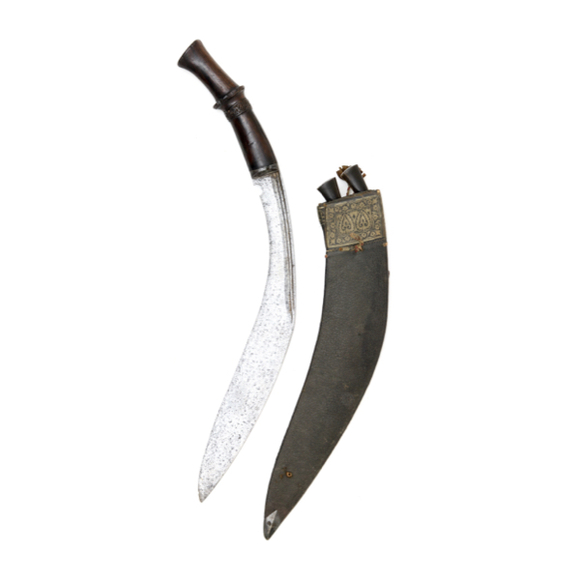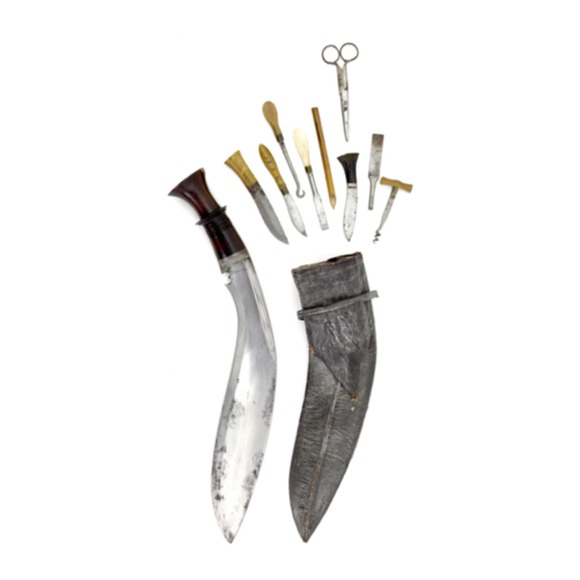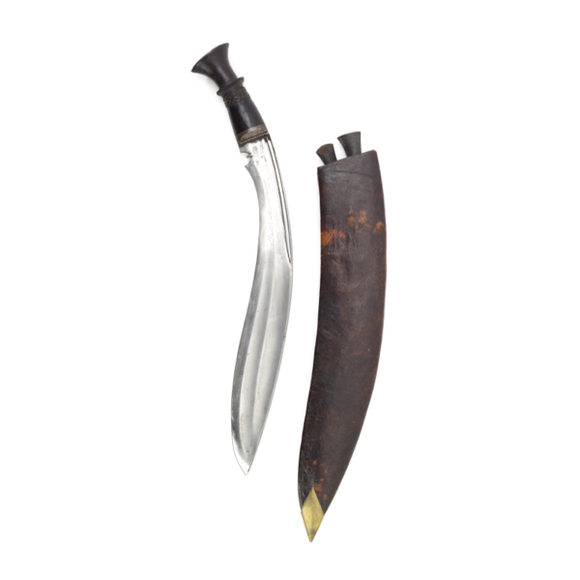Language: Persian derived
Description
Nimcha is the common name for a type of shortish saber used in North Africa from around the 16th century onwards. They have a characteristic hilt with a guard with four protrusions, one forming a knuckle guard and the others forming quillons.
Scholars believe Algeria was the main production center, with blades are often imported from Europe.1 Local productions are also encountered. Nimcha of the 17th and 18th centuries tend to have deeply curved blades that flare towards the end.

Nimcha, circa 1650s. Blade stamped: "Work of Al Hajj Mohammed"
Author's collection.
By the late 18th century, the prevalent blade had become longer, narrower, and straighter.

A high-quality 19th-century nimcha, acquired in 1880.
Victoria & Albert Museum accession number 374:1, 2-1880.
Notes
1. David G. Alexander; Islamic Arms and Armor in The Metropolitan Museum of Art. Yale University Press. 2015. Pages 178-179.
Barbary Corsairs
They were famously used by the Barbary Corsair pirates, who were a major threat to trading vessels and coastal towns. They were considered pirates but in reality were usually privateers, paid by local rulers who got a cut from their profits. They raided ships for loot and sold their crews to the Arab slave markets. They also committed raids on European towns, sometimes capturing as many as 1000 slaves in a single expedition.
Barbary pirate ships had motley crews, mainly consisting of North African Berbers, but some notable European pirates were also active. For example, Jan Janszoon van Haarlem, who was initially captured, converted to Islam and turned Corsair under the name Reis Mourad the Younger. He famously captured 107 people from Baltimore, Ireland, in 1631 to sell them in the Algiers slave market, and helped establish the Republic of Salé, a Corsair pirate lair.

Corsair pirates attacking a French ship. These slave-operated galleys were their typical mode of transport.
By Aert Anthoniszoon, circa 1615.
Royal Museums Greenwich, accession number BHC0709.

Captain Lambart, with 6 Dutch ships, publicly executes 125 captured pirates for the people of Algiers to see,
an attempt to pressure the release of captured allies made slaves.
By Jan Luyken, 1682-1683, but describing a 1619 event.
Rijksmuseum accession number RP-P-OB-80.916.

Slave market of Ottoman Algeria, by Jan Luyken, 1684.
Amsterdam Historic Museum.
Early nimcha
The earliest example of the typical nimcha hilt form is seen on a sword with a broad, straight Italian blade, kept in the Hofjagd- und Rüstkammer of the Kunsthistorisches Museum in Vienna.
The hilt and scabbard mounts are attributed to the court workshop of the Ottoman sultan Murad III (reigned 1574–95), and was probably the work of the head court jeweler, the Bosnian Mehmed ibn ‘Imad. For Mehmed ibn ‘Imad.1
The Italian blade dates from circa 1530.

Court workshop of the Ottoman sultan Murad III (reigned 1574–95)
Kunsthistorisches Museum Vienna
Hofjagd- und Rüstkammer C 180
The earliest depiction of a nimcha that I am aware of, is one worn by Abd el-Ouahed ben Messaoud ben Mohammed Anoun, Moorish Ambassador to Queen Elizabeth I who came to propose an alliance against the Spanish. The portrait was made in 1600.

Abd el-Ouahed ben Messaoud ben Mohammed Anoun, Moorish Ambassador to Queen Elizabeth I
University of Birmingham, accession number A0427
Another less expected depiction of a nimcha is one worn by militia captain Tobias Blosse in a portrait that is thought to date from around 1627-1628.

Portrait of Tobias Blosse, captain of a militia, wearing a nimcha. Circa 1627-1678.
Colchester and Ipswich Museums Service: Ipswich Borough Council Collection accession number R.1958-211.
References
1. David G. Alexander; Islamic Arms and Armor in The Metropolitan Museum of Art. Yale University Press. 2015. Pages 178-179.
Notable examples of the 17th century
Nimcha of Michiel de Ruyter, acquired 1655
Michiel de Ruyter famously fought off the Barbary Corsairs in a series of campaigns in the mid-17th century. The earliest provenanced nimcha I am aware of was reputedly captured by de Ruyter from a Barbary Corsair pirate by de Ruyter in Salé in 1655. It is now in the Rijksmuseum, Amsterdam.

Nimcha of Dutch admiral Michiel de Ruyter (1607-1676)
Rijksmuseum accession number NG-NM-10412
Nimcha of Michiel de Ruyter, acquired 1650s-1660s
A second nimcha in the same collection is also said to be captured by de Ruyter, but no place or date is given.

Nimcha of Dutch admiral Michiel de Ruyter (1607-1676)
Rijksmuseum accession number NG-NM-10413
Nimcha of Cornelis Tromp, acquired 1650s-1660s
The next nimcha was owned by Cornelis Tromp. another Dutch admiral who fought the Barbary pirates in the Mediterranean. It is unclear when or how he obtained it, but it was also likely loot from one of his expeditions against the pirates in the 1650s and 1660s.
The scabbard is a later Dutch addition.

Nimcha of Dutch admiral Cornelis Tromp (1629-1691)
Rijksmuseum accession number NG-NM-6095
Nimcha of Vice-Admiral Sir Thomas Hopsonn, acquired 1676
The next nimcha was captured by British vice admiral Sir Thomas Hopsonn in the 1670s. According to family tradition:
"When Lieutenant about 1670, boarded a Turkish ship and, being the first on board, the Captain of that vessel was in the act of cutting him down
when he arrested the stroke, wrenched the sabre from his opponent's hand and slew him with his own weapon"
The action took place about 1676 when Hopsonn was a First Lieutenant on the "Dragon" in the Mediterranean, and was battling Barbary Corsair pirates.

Nimcha of Vice-Admiral Sir Thomas Hopsonn (1642-1717)
Royal Museums Greenwich accession number WPN1057
Nimcha stamped with the tuğra of Mustafa II, 1695–1703
This is in the Kunsthistorisches Museum, Vienna. At first glance, it looks very similar to Rijksmuseum accession number NG-NM-10412 which was captured by Michiel de Ruyter in 1655. However, the center tortoise-covered panel is narrower, and the engraving differs from the earliest provenanced examples.

Nimcha with the tuğra of Mustafa II, 1695–1703
Kunsthistorisches Museum, Vienna
Accession number C.184.
Nimcha in various museums
A beautifully preserved example is in the Metropolitan Museum, accession number 36.25.1550a, b. The museum dates it at the late 17th to early 18th century, based on a number of them captured in the Battle of Oran in 1732. They are now kept in the Real Armería, Madrid, accession numbers M-42 to M-46. However, it is very similar to the one de Ruyter captured, so this group may be about 70-80 years older than assumed.

Two more are in the Victoria and Albert Museum; accession numbers 981-1884 and 374:1, 2-1880. The former is very similar to the piece captured by Sir Thomas Hopsonn shown above, and is most likely of the same date. The latter is of 19th-century make, with the long, straight blade typical for this period, and was acquired in 1880.
Others are in the:
Askeri Müzesi, Istanbul, accession number 2756.
Kremlin Armory, Moscow, accession number 6022, from Peter the Great's armory.
Topkapı Sarayı Museum, Istanbul, accession numbers 1/5074, 1/2756. Both with European blades, the latter stamped “GENOA”.
The Furusiyya Art Foundation, Vaduz, accession number no. R-252.
Etymology
The word nimcha can mean small or half. It appears in an 1852 Persian-English dictionary as:
"Nimcha, A short upper garment. A small, little, or short sword, musket, or bow."
-John Richardson and Sir Charles Wilkins;
A dictionary, Persian, Arabic, and English
W.H. Allen, London. 1852. Page 1347.
We also see the word nimcha appear in old Indian writings, for example, in the Sri Rajmala, the state chronicles of Tripura, a Hindu state in the Bengal higlands that was one of the last areas to fall under Muslim rule. It mentions a nimcha being presented by the Raja of Tripura to Mughal prince Shah Suja (1616-1661), second son of Emperor Shah Jahan. It is unclear whether this refers to the same type of sword.1
Two other Indian swords described as nimcha are mentioned by Egerton in 1880, but both were not illustrated in the book.2
584 I. Sabre; "Nímcha or Teghá;" iron hilt. Date about 1780.
"Used chiefly by men of high rank." (336.)
685. Sabre; "Nímcha;" grooved blade; steel hilt; red leather scabbard.
Vizianagram, L. 2 ft. 8 in. (7313.-'67.)
Notes
1. Journal of the Asiatic Society of Bengal. Edited by the Secretaries. Vol 7. Baptist Mission Press, Calcutta, 1851. Page 552.
2. Lord Wilbraham Egerton; An Illustrated Handbook of Indian Arms. W.H. Allen, London. 1880. Pages 101-102.






